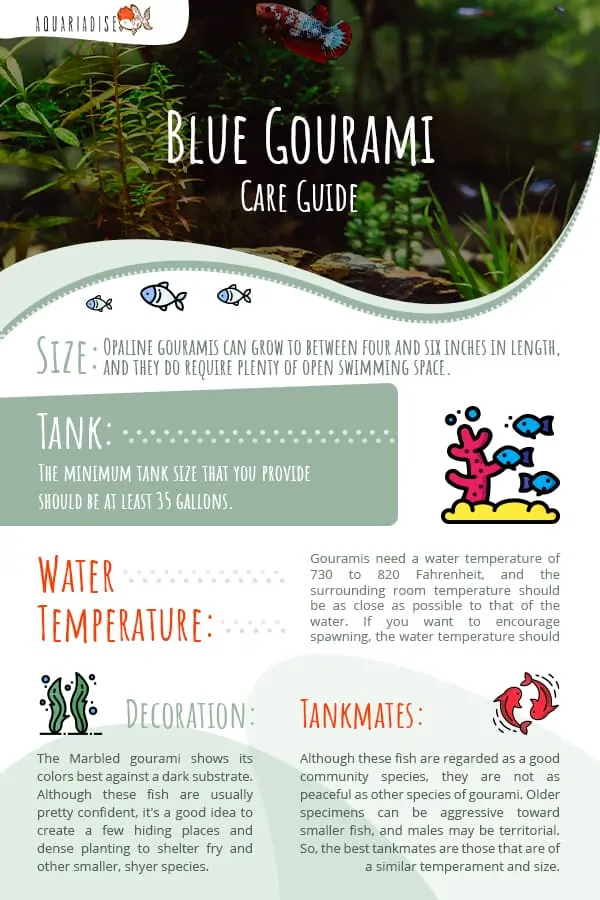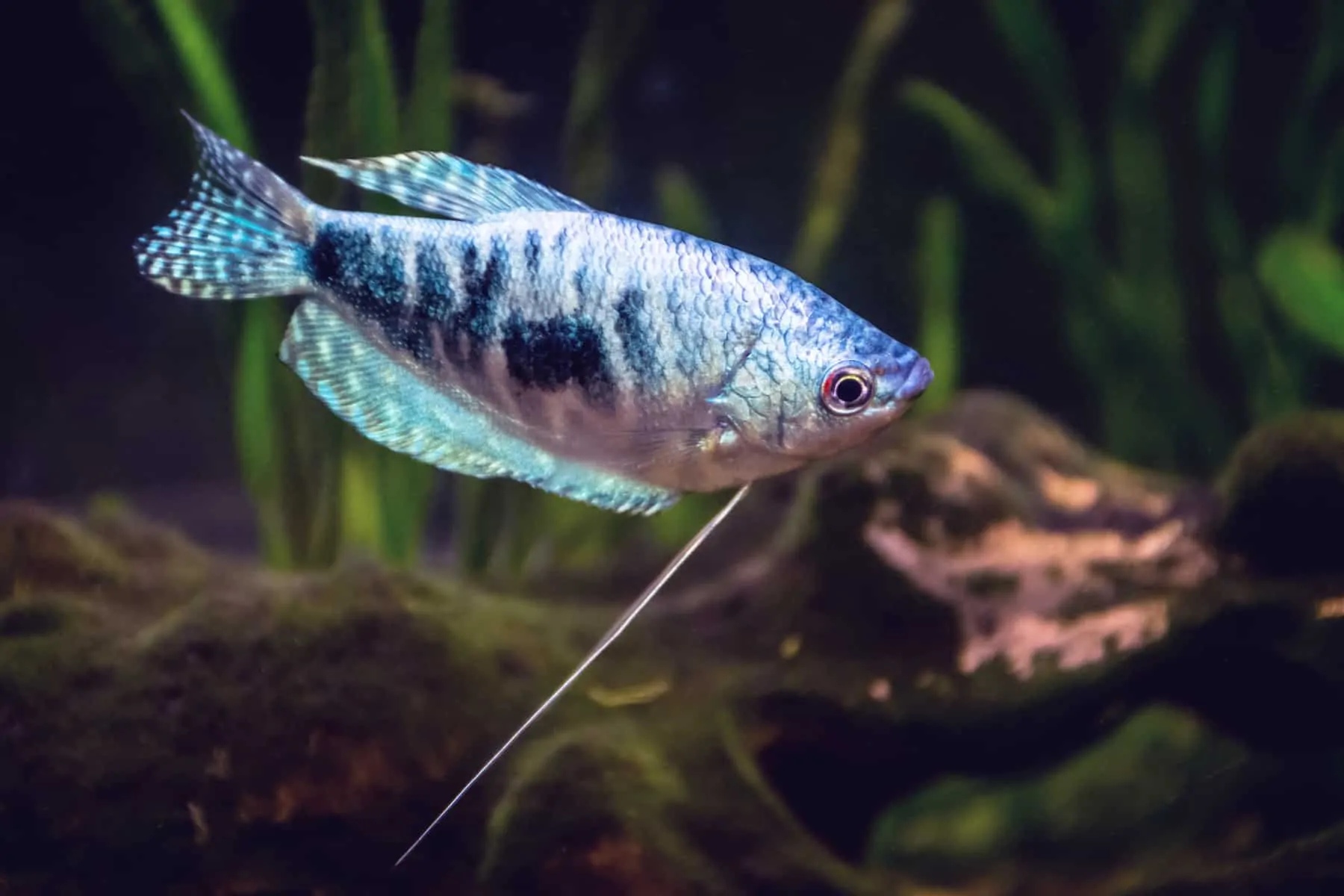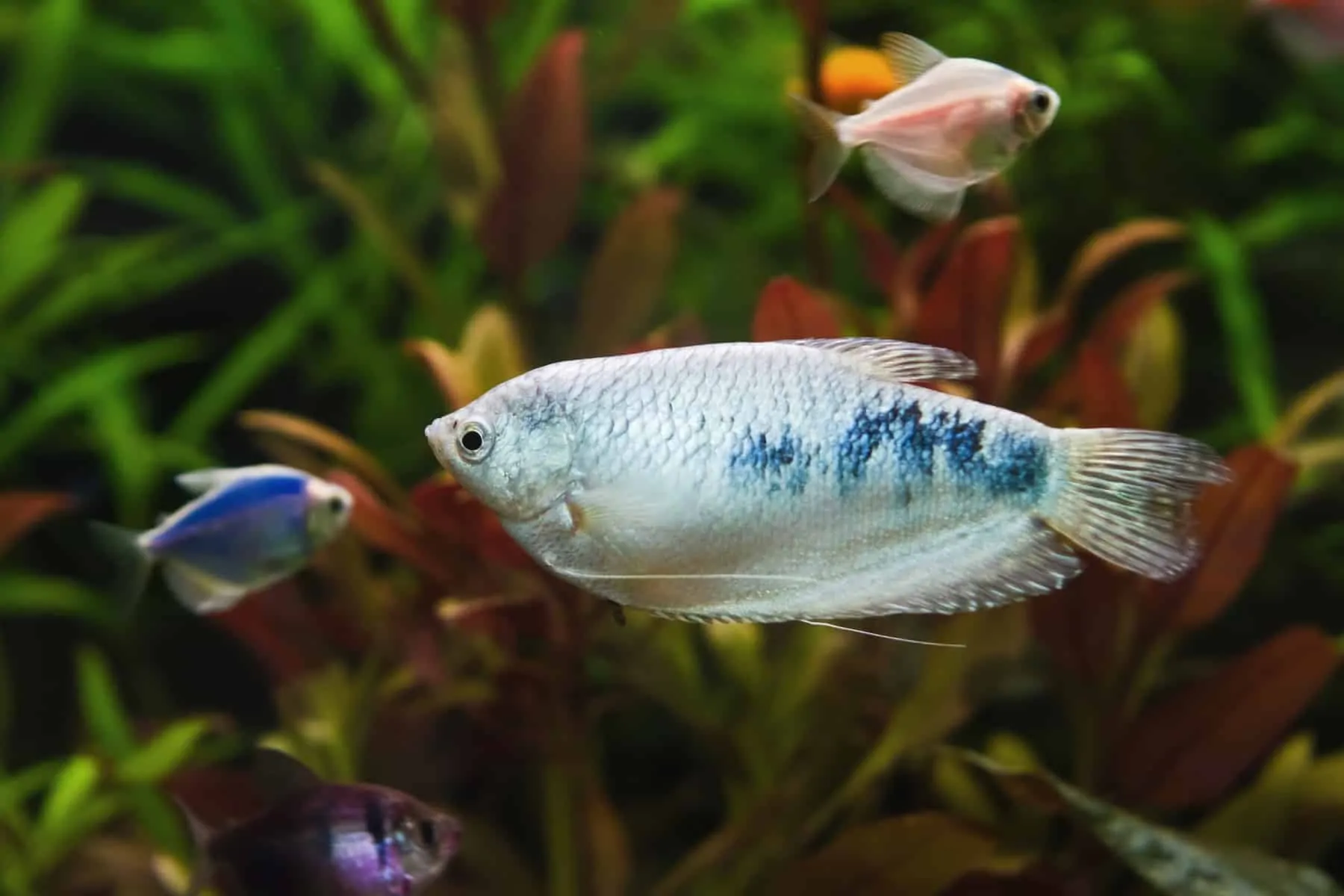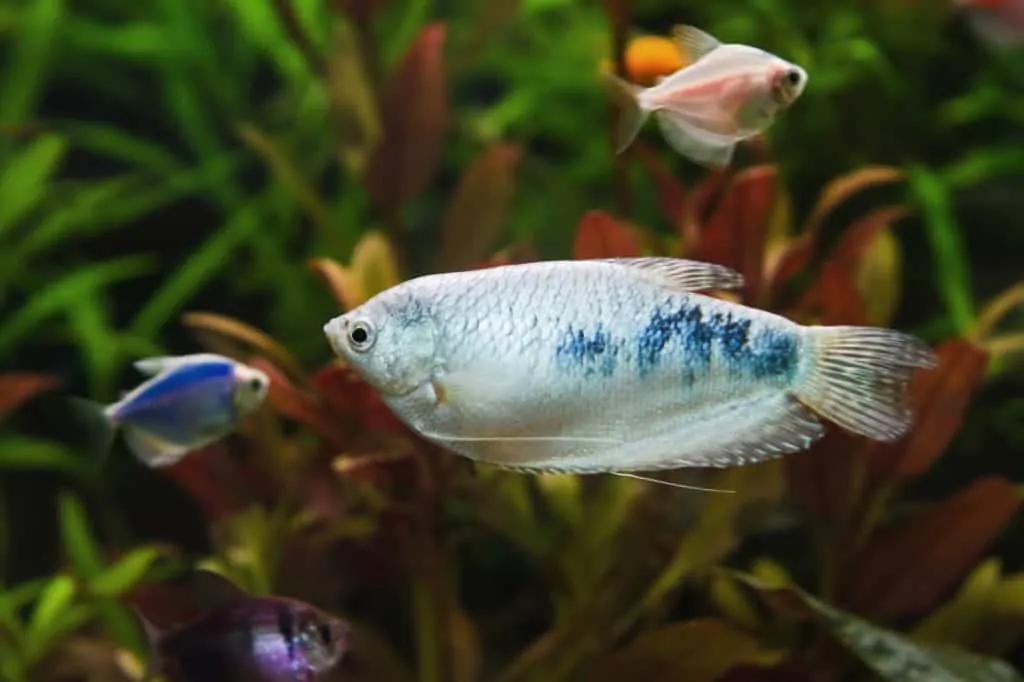The Opaline gourami is also known as the Marbled gourami and is a color variant of the Blue gourami or Three-spot gourami, and you may find these fish in your local fish store under these names. The scientific name of the Opaline gourami is, trichopodus trichopterus, formerly trichogaster trichopterus.
The variable, attractive patterns of the Opaline gourami, and its peaceful nature make this fish a popular addition to many community tanks. However, male marbled gouramis can be territorial with each other, although that behavior is not usually a problem provided that the tank is large enough.
In this guide, we tell you everything that you need to know about the care of the Opaline gourami, including the perfect tank setup, what food to offer your fish, and which species make the best tankmates.

Opaline gourami origins
The Opaline gourami does not occur in the wild.
However, Three-spot gouramis are found in southeastern Asia, from the Yunnan in China through Cambodia, Malaysia, Laos, Myanmar, Thailand, Singapore, and Vietnam, through to Java, Sumatra, and Borneo. The species is also found in parts of India, Sulawesi, the Philippines, and Trinidad.
The fish inhabits lowland wetland areas, including swamps, marshes, peatlands, canals, and slow-flowing streams, preferring heavily planted, sluggish, or standing water. Gouramis are omnivorous, feeding on small crustaceans, zooplankton, and insect larvae.
Creating the Opaline gourami
The Opaline gourami is a variety of Three-spot gourami. Commercial fish breeders in Eastern Europe and the Far East pair individuals for their coloration, producing enhanced colors over several generations. Back in 1970, the Gold and Platinum gourami were produced, adding to this already very popular variety of aquarium fish.
The predecessor to the modern Opaline gourami is the Cosby gourami that was developed in the USA by a breeder of that name. The Cosby gourami is a form of early Blue gourami with a silver-blue base color enhanced with darker blue markings, and it’s from that that the Opaline gourami is derived.
Thanks to the inbreeding that takes place to create new colors, you would be well advised to take great care when you’re looking for fish to buy. Look out for fish that are free-from obvious skeletal deformities or injuries. That said, Opaline gouramis are generally long-lived and are some of the hardiest aquarium fish available, making them an excellent choice for newbie hobbyists.

Description
Trichogaster trichopterus is a long, oval-shaped fish that has large, rounded fins. The ventral fins are long, flowing, and threadlike and are used by the fish as sensory organs thanks to their touch-sensitive cells.
Opaline gouramis have a labyrinth organ. The labyrinth organ is a respiratory organ that allows the fish to absorb oxygen from the air into its blood. Gourami fish can grow to around six inches in length, reaching breeding condition at around three inches. These are long-lived fish, having a lifespan of between four and six years on average.
The fish’s body is pale blue with a darker, marbled patterning that varies across all color forms. Typically, dark splotches appear at the base of the tail and pectoral fins, creating a beautiful pattern.
Care of the Opaline gourami
Gouramis are very easy fishes to care for, and they are hardy too. So, by offering your fish the very best care, you can look forward to enjoying a beautiful, long-lived specimen to display in your tank.
Tank setup
As we’ve mentioned, Opaline gouramis can grow to between four and six inches in length, and they do require plenty of open swimming space. So, the minimum tank size that you provide should be at least 35 gallons.
Although the gourami’s labyrinth organ enables the fish to survive in oxygen-depleted water, that doesn’t mean that water changes are unnecessary, and these fish will suffer the same health conditions as any other species if left to live in a dirty environment.
So, the tank must have an efficient filtration system, and 25% water changes should be carried out each week. The current created by the filtration system should not be too strong, as that will stress the gouramis.
Opaline gouramis swim in all areas of the water column, although a long tank is better than a tall one because of the species’ habit of using its labyrinth organ to take gulps of air from the surface from time-to-time. If possible, the temperature of the room in which the tank is situated should be as close as possible to that of the tank water, so as not to damage the labyrinth organ.
Water conditions
Gouramis need a water temperature of 730 to 820 Fahrenheit, and the surrounding room temperature should be as close as possible to that of the water. If you want to encourage spawning, the water temperature should be around 800 Fahrenheit.
The water pH should be in the range of 6.0 to 8.8, with a hardness of between 5 and 35 dGH.
Tank decoration
The Marbled gourami shows its colors best against a dark substrate. Although these fish are usually pretty confident, it’s a good idea to create a few hiding places and dense planting to shelter fry and other smaller, shyer species.
Although gouramis are omnivorous, they won’t bother your plants and often enjoy exploring in and around the stems and leaves. Floating plants are also a good addition to the aquarium, as they help to diffuse bright lighting. However, you must prune out excess growth that could prevent the fish from accessing the surface to breathe, using their labyrinth organ.
Tankmates
Although these fish are regarded as a good community species, they are not as peaceful as other species of gourami. Older specimens can be aggressive toward smaller fish, and males may be territorial. So, the best tankmates are those that are of a similar temperament and size.
Also, Opaline gouramis have individual temperaments. Some are peaceful and almost shy in their behavior, whereas others are aggressive bullies who will hassle their smaller tankmates. When choosing tankmates for your Opaline gouramis, avoid species that are known to be fin nippers and very small fish that could be viewed as prey.
Suitable tankmates for these fish include:
- barbs
- characins
- loricariid catfish
- loaches
Other species of medium to large gouramis can usually be included in the mix without problems. Snails and invertebrates are usually safe, as long as they are of a large size. However, shrimp eggs and larvae will most likely be eaten by the gouramis, so be sure to segregate the species if you want to breed shrimp.
Diet and nutrition
Opaline gouramis are omnivorous and will accept a wide variety of fresh, live, flake, pellet, and frozen foods. A well-balanced diet should include a good-quality pellet or flake food, supplemented with bloodworms, white worm, brine shrimp, and similar. You can also offer fresh vegetables, such as blanched lettuce.
Feed your fish once or twice per day, offering just enough food to last for a minute or two.
Breeding
Opaline gouramis spawn readily in the home aquarium, making breeding them a fun project for the newbie tropical fish keeper.
Differentiating between the species is relatively straightforward. Male specimens have a longer, more pointed dorsal fin than their female counterparts, which have a shorter, rounder dorsal.
Opaline gouramis are bubble nest builders and are easy to breed, provided that the tank conditions are right.
The breeding tank
Provide the fish with a separate, shallow breeding tank. Keep the water to a depth of around five to six inches, and be sure to keep the current in the tank to a minimum. Some peat filtration or a small, air-powered sponge filter will help to keep the water clean while providing minimal disruption.
Water temperature should be around 800 Fahrenheit, and there should be an adequate surface area. The tank should be densely planted with long stem plants that grow to the surface to help keep the bubble nest in place.
Introduce a healthy pair of adult fish to the breeding tank, and offer them small portions of live and frozen food two to three times a day to bring the female fish into spawning condition. Females will begin to fill out with eggs when spawning is imminent.
The male fish will busy himself building a bubble nest. Once the nest is complete, the male will display to the female, flaring his fins and raising his tail to encourage her to spawn beneath the nest. The eggs are lighter than water and will float up into the nest. There can be between 700 to 800 eggs in one spawn!
As soon as the eggs are laid, remove the female. Male gouramis guard their eggs fiercely until they hatch and have been known to kill the female fish. Watch closely for the fry to hatch. As soon as hatching occurs, the fry feeds on the egg sacs for a day or so. Once the fry is free-swimming, the male should be removed from the tank as he may eat the fry.
You can feed the fry a liquid fry food or infusoria until they are large enough to eat baby brine shrimp.
Diseases
The Opaline gourami is a very hardy species that will remain healthy and thrive in a well-maintained tank. Problems generally occur if the water quality is poor, the temperature is too low, or the fish are not fed a balanced, nutritious diet.
Common fish diseases that may affect gouramis include:
- constipation
- bacterial infections
- Hole in the Head disease
- Ich

Constipation
Fish with constipation usually have problems in swimming, floating up to the water surface, or becoming trapped on the substrate. That can be a real problem for labyrinth breathers, including gouramis.
The condition is usually caused by a food blockage in the fish’s digestive system and is easily remedied by starving the fish for a day or two and then feeding them a shelled pea or some live food.
Bacterial infections
Certain species of bacteria live undetected in most fish tanks, causing no problems until the fish become stressed and weakened, usually by poor water conditions or incorrect feeding.
Most times, you can fix bacterial infections by remedying the water condition issues and treating the tank water with an appropriate proprietary over-the-counter medication that you’ll find in your local fish store.
Hole in the Head disease
Thought to be caused by a parasite, Hole in the Head disease causes pitted lesions on the fish’s lateral line and head. The condition is made worse by environmental changes and poor water conditions. As the holes become larger, secondary fungal and bacterial infections develop. Ultimately, the lesions get worse, and severe infection usually kills the fish.
Provided that you catch it early, the condition can be treated by adding an antibiotic to the tank water.
Ich
Ich is a disease that’s caused by the Ichthophthirius multifiliis parasite. The condition is also commonly known as white spot disease, so named for the scattering of tiny white spots across the fish’s body, fins, gills, and tail. Affected fish will flick or rub themselves against the substrate or tank decorations in an attempt to dislodge the parasites and relieve the irritation that they cause.
Ich is easily treated by adding an over-the-counter preparation to the tank water.
The Ich parasite is present in most tanks, only becoming a problem when fish are weakened due to stress or disease.
Disease prevention
Any new fish should be quarantined before the introduction to your main display tank, and new substrate, plants, and tank ornaments should be thoroughly cleaned before you put them into your main tank.
Also, correct feeding and keeping the tank water clean and within the correct parameters for your fish will help to prevent stressing the fish, which leaves them vulnerable to disease.
Availability
Most species of gouramis, including the Opaline variety, are available from most good fish stores and online, and they are relatively inexpensive to buy, making them an excellent choice for the beginner aquarist.
FAQ
In this part of our comprehensive guide, we provide the answers to some of the most frequently asked questions about keeping Opaline gouramis.
Q: Are Opaline Gouramis aggressive?
A: The species is generally peaceful, although males can become territorial as they get older.
Q: How big do Opaline Gouramis get?
A: These fish grow to between four and six inches in length when mature and should, therefore, be kept in a large aquarium. That’s an important point to bear in mind when buying small juvenile fish to add to your community.
Q: Why do Opaline Gouramis change color?
A: Members of the Three-spot gourami family are known to change color when stressed or kept in poor conditions. So, if your fish change color or their patterns fade, check your water quality and observe the tank to make sure that no bullying is going on among members of the community.
Q: How can you tell a male from female gourami?
A: Male gouramis have a longer, more pointed dorsal fin than females, which have a shorter, rounder dorsal fin. Female gouramis considerably swell when ready to spawn and filled with eggs.
In summary
The Opaline gourami is a beautiful fish that makes an attractive and interesting addition to a community tank. Although generally peaceful as youngsters, older male fish can become aggressive and territorial toward their own species and other smaller fish.
You’ll need a tank of a decent size to accommodate this gourami species, as they do like plenty of room to swim. Also, your tank should provide good access to the water’s surface so that these labyrinth breathers can take gulps of oxygen when they need to.
These gouramis breed well in a tank environment, which can make a fascinating and rewarding project for new hobbyists.


